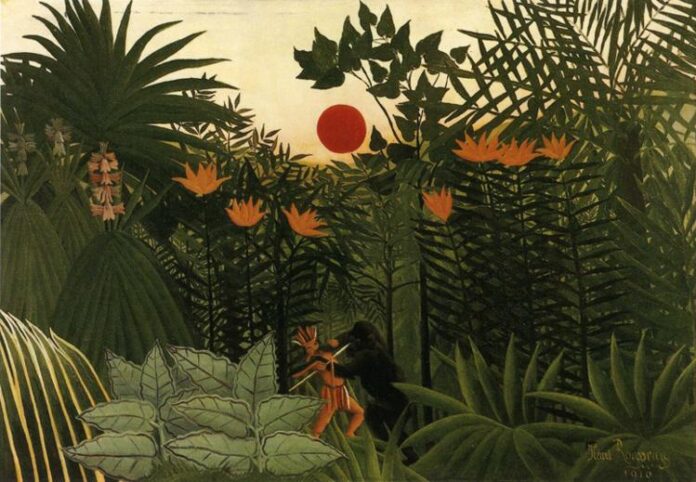The conventional style paintings by Van Gogh and Da Vinci are well-known to art enthusiasts. However, naive art, or works with childlike simplicity, display another unique style. Henri Rousseau is one artist who achieved fame for this aesthetic.
Despite having set his eyes on becoming a well-known academic painter, Rousseau strangely turned out to be the epitome of a naive artist. Rousseau, who was largely self-taught, established a style that exposed his lack of formal education.
One-point perspective, an absence of proper proportions, and the use of striking, frequently unnatural colours produced a body of work that was unusual and shrouded in mystery. For example, in another of Henri Rousseau’s art, bananas are depicted growing upside-down, while in other works, he combines species from several geographies that would never naturally coexist.
Accomplishments
Despite aspirations to become a well-known academic painter, world-famous painter Henri Rousseau was the stereotypical “naive” artist. Rousseau, who was largely self-taught, produced a style that, with its lack of proper dimensions, one-point viewpoint, and use of strong, frequently artificial colours, demonstrated his lack of formal education. These characteristics led to a corpus of work infused with an air of mystery and oddity.
Many of Rousseau’s early admirers mocked his untrained and eccentric style, with one Parisian writer famously remarking that “Mister Rousseau draws with his feet and his eyes closed.” However, by borrowing influence from African tribal masquerades and other “primitive” and classic art forms, modern painters like Picasso found that Rousseau’s work embodied the authenticity and incisiveness they sought in their work.
Rousseau’s modern, unusual depictions of classic genres like portraiture, landscape, and allegory were influenced by various “higher” and “lower” sources, including academic sculptures, tabloid graphics, postcards, and visits to the Paris national zoo and gardens. In addition, the Surrealists, whose art emphasised unexpected juxtapositions and trance moods typical of Rousseau’s work, praised the bizarre, frequently ridiculous imagery that arose from these hybrid inspirations, most famously, a nude woman relaxing on a divan mysteriously found in a tropical jungle.
Criticism and appreciation
Many critics devalued Rousseau’s flat, somewhat juvenile style; they frequently expressed shock or mockery at his writing. But on the other hand, many onlookers remarked that he painted in a childlike manner.
Rousseau’s artwork appeared rough and unpleasant to the slick, academic painting standards of the 19th century. His forms and backgrounds were awkward and clumsy, his use of colour, mainly black, was eccentric, and he could not paint feet.
Additionally, he did lack a solid bit of perspective. Though eventually, it was his paintings that brought him a long-lasting reputation, particularly the magical, opulent forest themes that were so beautiful.
He had a distinctive fashion and sway
Due to his low resources, painter Henri Rousseau used student-grade paint and spent significant time creating each painting, which accounts for his small body of work. In addition, his method of painting was particularly distinctive since he added numerous layers to each piece by adding one coat of paint at a time.
He worked from top to bottom, one at a time, starting with the blues and then on to the greens. Rousseau frequently employed more than 50 different hues of green while depicting jungle scenes. The best Henri Rousseau paintings involved these amazing jungle scenes.
His meticulous brushwork mixing that produces a smooth finish exemplifies his distinctive painting style. His use of precise brushstrokes, which give each element in the painting the appearance of being outlined, was another aspect of his approach.
The Surrealists and Cubists drew substantially from Rousseau’s work because of its heavy reliance on line, rigid portraiture, erratic juxtapositions, and flattened perspective. However, the foundation of his work was his imagination.
Henri Rousseau’s jungle paintings
Despite being mocked in the past, Henri Rousseau’s jungle paintings significantly impacted important painters. Their interest was piqued by the sincere sentiment and very decorative nature of his works. His untaught approach and sense of innocent simplicity echoed the ‘primitivism’ favoured by early 20th-century modern painters like Pablo Picasso and Wassily. They sought genres like Russian folk art and African tribal masks in search of a more ‘primal’ form of expression.
In honour of his genius, Picasso bought a Rousseau painting he had seen being offered on the roadside as a piece of canvas to be colored over. Rousseau’s use of vivid colours and distinct shapes, as well as his art’s absurdist and metaphysical nature, caused André Breton to refer to him as a “proto-Surrealist;” foreshadowing the creations of the legends Rene Magritte and Giorgio de Chirico.
Rousseau’s work influenced painters of the following generation and beyond because it was endowed with a wonderfully alluring strangeness that could create mystery among the ordinary and the exotic.
Following his passing, Rousseau’s acquaintances and fellow creatives were crucial in preserving his legacy. With a New York exposition in 1910, the artist Max Weber presented Rousseau’s paintings to American viewers.
The following year, Robert Delaunay arranged a memorial exhibition at the Salon des Indépendants. Wassily Kandinsky, who later bought two of Henri Rousseau’s paintings and included copies of his artwork in the Blaue Reiter Almanac, was profoundly influenced by Uhde’s publication of the first autobiography on Rousseau (1912).
Rousseau’s work produced a big impression on painters of many generations and beyond because it was endowed with an inexplicably alluring strangeness that could create wonder among the ordinary and the exotic.
Conclusion
Despite receiving criticism throughout his life, Rousseau’s aesthetic significantly impacted the avant-garde painters that came after him. Rousseau’s paintings also served as an inspiration for writers like Joni Mitchell and poets Sylvia Plath and Wallace Stevens.
Today, his works remain in the public domain; they’re highly regarded and scrutinised to a hitherto unsurpassed degree. This is simply amazing- no wonder countless art lovers have expressed universal admiration for Rousseau’s bold, transcending works that have catapulted art to new, unexplored heights.































































